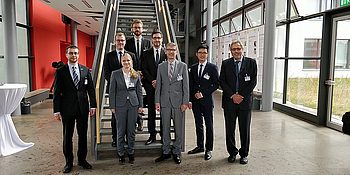CRC 1368 Oxygen-free production
The CRC "Oxygen-free production: Processes and effective zones in an oxygen-free atmosphere for the development of sustainable production techniques and manufacturing processes" is a joint research area of Leibniz University of Hannover and TU Clausthal under the leadership of the Institute of Materials Science (Hannover).
Subproject C05 Joining simulation
Since January 2020, we have been collaborating in the CRC on "Oxygen-free production", which is funded by the German Research Foundation with around 9.5 million euros for the years 2023 to 2023 and with 10.5 million euro for the next four years from 2024 on. The aim of the CRC scientists is to develop and establish a production technology under oxygen-free conditions that opens up fascinating new possibilities. This will make it possible to realize new, energy-efficient and resource-saving processes and an overall more efficient production. With the help of novel processes, oxygen is to be reduced to previously unattained low levels. These values are orders of magnitude lower than in technically generated ultra-high vacuum.
Prof. Dr.-Ing. Hans Jürgen Maier, Director of the Institute of Materials Science at the Hannover Centre for Production Technology and spokesman of the CRC, which officially starts on January 1, 2020, explains the challenge: "Wherever two metals come into direct contact with each other in production technology, it is actually not the metal atoms that touch each other, but the oxide layers on the respective surfaces that are formed by the oxygen in the environment. These oxide layers make it difficult to join workpieces, which is why we expect great advantages from oxide-layer-free materials in welding, soldering and additive production. Likewise, the wear of tools during machining and forming could be significantly reduced by the absence of oxygen".
In our project we concentrate on the fundamental questions of oxygen-free production. Here, modelling methods are used to gain a fundamental understanding of the processes and mechanisms in oxygen-free environments. These processes are considered on an atomic level to investigate the physical properties of the bonding of the joining partners in the contact zone using the example of roll bonding For further details see www.sfb1368.uni-hannover.de/de/forschung/projektbereich-c/teilprojekt-c05/.
In the first funding period, the focus will be on fundamental questions in the interface zone. Concrete production engineering processes of original forming, shaping, joining, separating and coating are then to be developed step by step.
Publication list
- H.-T. Luu, S. Raumel, F. Dencker, M. Wurz und N. Merkert. Nanoindentation in alumina coated Al: Molecular dynamics simulations and experiments. Surf. Coat. Tech. 437:128342, 2022.
- A. Plack, M. Bierwirth, A.P. Weber und N. Gunkelmann. Experimental and atomistic study of high speed collisions of gold nanoparticles with a gold substrate: Validation of interatomic potentials. J Aerosol Sci. 159:105846, 2021.
- H.-T. Luu, S.-L. Dang, T.-V. Hoang und N. Gunkelmann. Molecular dynamics simulation of nanoindentation in Al and Fe: On the influence of system characteristics. Appl. Surf. Science 551:149221, 2021.
- Y. Rosandi, H.-T. Luu, H. M. Urbassek und N. Gunkelmann, Molecular Dynamics Simulations of the Mechanical Behavior of Alumina Coated Aluminum Nanowires under Tension and Compression, RSC Advances, 10, 1435, 2020.

Clausthal participants in the new CRC, Photo: Maximilian Weiss/LUH